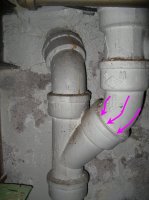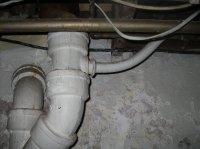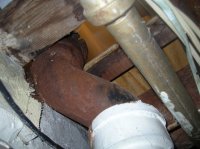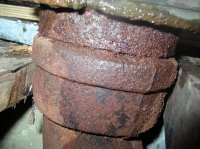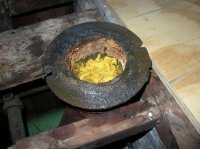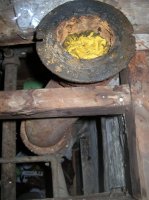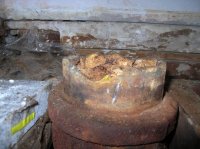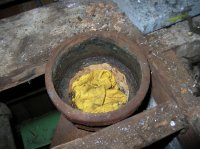Mr Blint
New Member
1940s-era house with cast-iron waste pipes. The tongue-and-groove subfloor was in bad shape and has been removed. I plan to put down two layers of 3/4 plywood, isolation membrane, and tile.
As the pictures show, the toilet flange is corroded and the inside of the pipe is very pitted. I suspect that pitting on the inside wall would prevent one of the rubber-gasketed PVC flange inserts from making a good and tight seal against the pipe.
I've removed the wax and scrubbed the flange with a wire brush and mineral spirits. That's what that liquid is on the flange.
I would be very grateful for some expert advice on my Plan A, Plan B, and Plan C.
Thanks
Plan A
The flange is still solid, not crumbling. Reinforce the flange with metal "cleats". Then slather the flange with lots of plumbers paste and use a "Sani" style "springy" rubber-foam toilet gasket rather than a wax ring.
PROS: I am not likely to cause any major damage!
CONS: The plywood won't be underneath the flange, and the toilet's weight will be on the flange. It has been that way for decades already. Eventually the flange may begin to leak and I'll wish then that I'd done a more thorough job.
Plan B
Drill out the lead seal from around the toilet flange and try to remove the flange gingerly without damaging the waste pipe. Reinstall a new cast iron flange.
PROS: The plywood can go right up to the waste pipe so the flange can be screwed to plywood. This repair should be durable and last a good long time.
CONS: I've never done this. Never melted lead, don't have a torch or a little crucible or the caulking irons; I also don't know yet how to tell the difference between Xtra Heavy or Service Weight cast iron and might get an incompatible flange.
Plan C.
If I damage the waste pipe when trying to remove the old flange, I will then have to try to remove the section of cast-iron pipe either directly below the floor, or farther down in the basement, near where it enters the main waste pipe. We would either replace that section of pipe with the same thing, or if we remove farther down in the basement, we would transition from cast iron to 3" PVC.
PROS: The powder room waste is on its own small branch, so there is no weight of the cast iron from upper storeys resting on the section of pipe that would be cut out. I have also worked a lot with PVC and it should be fairly smooth sailing from that point on.
CONS: If I damage the cast iron hub in the basement when trying to remove that section of powder-room waste pipe, then I'm really up sh*t creek. :-(
I've never melted lead, don't have the torch and tools, etc etc.
I have to find out if a rubber donut-style gasket, which sits in the cast-iron hub, in order to make a transition to PVC, is up to code in Pennsylvania.
As the pictures show, the toilet flange is corroded and the inside of the pipe is very pitted. I suspect that pitting on the inside wall would prevent one of the rubber-gasketed PVC flange inserts from making a good and tight seal against the pipe.
I've removed the wax and scrubbed the flange with a wire brush and mineral spirits. That's what that liquid is on the flange.
I would be very grateful for some expert advice on my Plan A, Plan B, and Plan C.
Thanks
Plan A
The flange is still solid, not crumbling. Reinforce the flange with metal "cleats". Then slather the flange with lots of plumbers paste and use a "Sani" style "springy" rubber-foam toilet gasket rather than a wax ring.
PROS: I am not likely to cause any major damage!
CONS: The plywood won't be underneath the flange, and the toilet's weight will be on the flange. It has been that way for decades already. Eventually the flange may begin to leak and I'll wish then that I'd done a more thorough job.
Plan B
Drill out the lead seal from around the toilet flange and try to remove the flange gingerly without damaging the waste pipe. Reinstall a new cast iron flange.
PROS: The plywood can go right up to the waste pipe so the flange can be screwed to plywood. This repair should be durable and last a good long time.
CONS: I've never done this. Never melted lead, don't have a torch or a little crucible or the caulking irons; I also don't know yet how to tell the difference between Xtra Heavy or Service Weight cast iron and might get an incompatible flange.
Plan C.
If I damage the waste pipe when trying to remove the old flange, I will then have to try to remove the section of cast-iron pipe either directly below the floor, or farther down in the basement, near where it enters the main waste pipe. We would either replace that section of pipe with the same thing, or if we remove farther down in the basement, we would transition from cast iron to 3" PVC.
PROS: The powder room waste is on its own small branch, so there is no weight of the cast iron from upper storeys resting on the section of pipe that would be cut out. I have also worked a lot with PVC and it should be fairly smooth sailing from that point on.
CONS: If I damage the cast iron hub in the basement when trying to remove that section of powder-room waste pipe, then I'm really up sh*t creek. :-(
I've never melted lead, don't have the torch and tools, etc etc.
I have to find out if a rubber donut-style gasket, which sits in the cast-iron hub, in order to make a transition to PVC, is up to code in Pennsylvania.
Attachments
Last edited:

